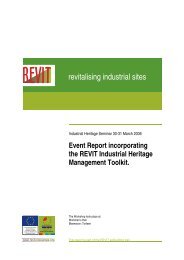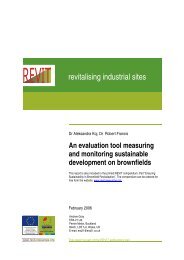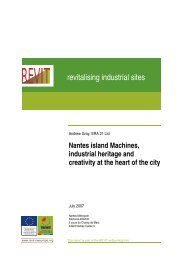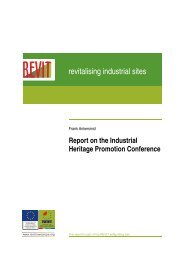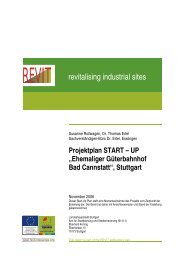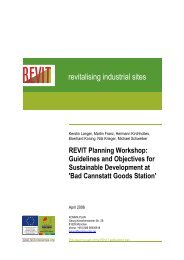REVIT Heritage Report.pdf
REVIT Heritage Report.pdf
REVIT Heritage Report.pdf
You also want an ePaper? Increase the reach of your titles
YUMPU automatically turns print PDFs into web optimized ePapers that Google loves.
Torfaen County Borough Council<br />
<strong>REVIT</strong>: A Review of the Conservation of Industrial <strong>Heritage</strong> Assets on Brownfield Sites<br />
• Cairns on the Blorenge;<br />
• Capel Newydd, Blaenavon;<br />
• (site of ) Ecclesiastical and Wells;<br />
• Cairn-y-Defaid Round Cairns;<br />
• Engine Pit, Blaenavon;<br />
• Garn-Ddyrys Ironworks and adjacent tramway;<br />
• Hill's Tramroad Inclines, Llanfoist;<br />
• Iron and Coal Patching, Pen-Ffordd-goch, Blaenavon;<br />
• Limekilns and Quarries at Craig-y-Hafod;<br />
• Lower Rank;<br />
• Pwll-du Tramroad, Tunnel, Southern approach;<br />
• Tramroad bridge, Bailey's Tramroad, Govilon;<br />
• Pwll-du Limestone Quarry and Water Balance Lift;<br />
• Blaenavon Workmen’s Hall;<br />
• Cwmavon Forge Row<br />
• St. Peter’s Church; and<br />
• St Peters School.<br />
4.2.24 The renovated St Peters School, of circa 1815, building will be used for the<br />
interpretation of industrial heritage and the building will become the focal point<br />
for the World <strong>Heritage</strong> site. The centre will utilise technology to explain the<br />
background of the area and will also have links to the other significant world<br />
heritage sites around the World.<br />
4.2.25 Blaenavon World <strong>Heritage</strong> Site is considered one of the finest surviving<br />
examples in the world of late 18th and early 19 th century landscape created by<br />
coalmining and ironmaking. The decline of this industry left a significant void in<br />
the economic activity of the area.<br />
4.2.26 The industrial landscape which grew up around the ironworks consisted of iron<br />
ore patches, coal mines, limestone quarries, iron forges, brickworks,<br />
tramroads, leats and reservoirs, chapels and workers’ houses. The main focus<br />
of the landscape is the Blaenavon Ironworks which is a Scheduled Ancient<br />
Monument in the care of Cadw.<br />
4.2.27 Blaenavon Ironworks is one of the most complete ironworks of its type and<br />
period in the world, with remains of five blast furnaces of various evolutionary<br />
forms from the 1780s to the 1860s. The site also includes a hot blast stove,<br />
cast houses, ore calcining kilns, coke ovens, a water-balance lift of 1839, a<br />
square of workers’ housing, a drift mine, a foundry, rail yards, and remains of<br />
chimneys, mould drying kilns, a blowing engine house and other ancillary<br />
structures. Iron ore was smelted at the ironworks to produce pig iron until<br />
1902.<br />
0014021/JM/001 22




